Home Tags Posts tagged with "North Korea"
North Korea
Anonymous has claimed it has been “hacking” and vandalizing social networking profiles linked to North Korea.
The hacking group has issued several warnings since North Korea’s threats have intensified.
Uriminzokkiri, a news site, has been forced offline – while Twitter and Flickr accounts have been breached.
Anonymous also claimed to have accessed 15,000 usernames and passwords from a university database.
As part of action which the loosely organized collective has called “Operation Free Korea”, the hackers have called for leader Kim Jong-un to step down, a democratic government to be put in place – and for North Koreans to get uncensored internet access.

Anonymous has claimed it has been “hacking” and vandalizing social networking profiles linked to North Korea
Currently, only a select few in the country have access to the “internet” – which is more akin to a closed company intranet with only a select few websites that are government-run.
North Korea recently allowed foreigners to access mobile internet, but this service has since been shut off.
In a message posted online, members of Anonymous wrote: “To the citizens of North Korea we suggest to rise up and bring [this] oppressive government down!
“We are holding your back and your hand, while you take the journey to freedom, democracy and peace.
“You are not alone. Don’t fear us, we are not terrorist, we are the good guys from the internet. AnonKorea and all the other Anons are here to set you free.”
Urminzokkiri’s Twitter feed started displaying messages reading “hacked” at around 07:00 BST. The account’s avatar was changed to a picture of two people dancing, with the words “Tango down”.
On Urminzokkiri’s Flickr photo page, other images, including a “wanted” poster mocking Kim Jong-un, were also posted.
Anonymous has posted what it said was a sample of the hacked information.
However, some have questioned the reliability of the details as some of the email addresses were in fact Chinese.
Also unreachable on Thursday was the website of Air Koryo, North Korea’s airline, which launched its online booking site late last year.
Like the main Urminzokkiri homepage, it is suspected the Air Koryo site has been hit with a Distributed Denial of Service attacked (DDoS) – a technique which involves flooding a website with too much traffic for it to handle.
Although a highly secretive nation, North Korea puts considerable effort in to having a strong presence online.
Various YouTube accounts attached to the North Korean regime post news items and propaganda videos on a regular basis.
North Korea has shifted a missile with “considerable range” to its east coast, South Korea’s Foreign Minister Kim Kwan-jin has announced.
Kim Kwan-jin played down concerns that the missile could target the US mainland, and said North Korea’s intentions were not yet clear.
Pyongyang earlier renewed threats of a nuclear strike against the US, though its missiles are not believed to be capable of carrying nuclear warheads.
The US is responding to North Korea by moving missile defense shields to Guam.
Meanwhile, Russia said Pyongyang’s attempts to “violate decisions of the UN Security Council are categorically unacceptable”.
“This radically complicates, if it doesn’t in practice shut off, the prospects for resuming six-party talks,” foreign ministry spokesman Alexander Lukashevich said in a statement on Thursday.

North Korea has shifted a missile with “considerable range” to its east coast
The talks involving North and South Korea, the US, Russia, China and Japan were last held in late 2008.
Japan said it was co-operating closely with the US and South Korea to monitor North Korea’s next move.
Japan’s PM Shinzo Abe said that although the rhetoric was “increasingly provocative”, Tokyo would “calmly” watch the situation.
Government spokesman Yoshihide Suga earlier told reporters that Japan was braced for a “worst-case scenario”.
The Pentagon said the shield on its Pacific island territory would be ready within weeks, adding to warships already sent to the area.
North Korea has previously named Guam among a list of possible targets for attack that included Hawaii and the US mainland.
Japanese and South Korean reports had suggested the missile being moved by North Korea was a long-range one with a capability of hitting the US west coast.
However, experts believe North Korea’s most powerful rocket, which it test-fired last December, has a range of 3,700 miles (6,000 km) and can reach no further than Alaska.
Kim Kwan-jin told MPs in a parliamentary defense committee meeting that the missile had “considerable range”.
“The missile does not seem to be aimed at the US mainland. It could be aimed at test firing or military drills,” he said.
Analysts have interpreted Kim Kwan-jin’s description as referring to the Musudan missile, estimated to have a range up to 2,500 miles (4,000 km). Guam would be within that range.
North Korea is believed to have its main military research centres in the east.
It has test-fired missiles from there before, and its three nuclear weapons tests were carried out in the east.
Despite its belligerent rhetoric, North Korea has not taken direct military action since 2010, when it shelled a South Korean island and killed four people.
In recent weeks North Korea has threatened nuclear strikes and attacks on specific targets in the US and South Korea.
The communist country has announced a formal declaration of war on the South, and pledged to reopen a mothballed nuclear reactor in defiance of UN Security Council resolutions.
In its latest statement, attributed to a military spokesman, North Korea appeared to refer to continuing military exercises between the US and South Korea in which the US has flown nuclear-capable bombers over the South.
The statement said the “ever-escalating US hostile policy towards the DPRK [North Korea] and its reckless nuclear threat will be smashed”.
North Korea promised to use “cutting-edge smaller, lighter and diversified nuclear strike means of the DPRK” and said the “merciless operation of its revolutionary armed forces in this regard has been finally examined and ratified”.
The US Department of Defense said on Wednesday it would deploy the ballistic Terminal High Altitude Area Defense System (THAAD) to Guam in the coming weeks.
The THAAD system includes a truck-mounted launcher and interceptor missiles.
US officials recently also announced that the USS John McCain, a destroyer capable of intercepting missiles, had been positioned off the Korean peninsula.
Some analysts say Pyongyang’s angry statements are of more concern than usual because it is unclear exactly what North Korea hopes to achieve.
As well as the angry statements, North Korea has also shut down an emergency telephone line between Seoul and Pyongyang and stopped South Koreans from working at Kaesong Industrial Complex in the North.
Kaesong industrial park, one of the last remaining symbols of co-operation between the neighbors, is staffed mainly by North Koreans but funded and managed by South Korean firms.
[youtube ZuoB_8dkAzc]
North Korea has announced today that its army had received final approval to launch “merciless” nuclear strikes against the US.
The General Staff of the Korean People’s Army said it was formally notifying Washington that US threats would be “smashed by… cutting-edge smaller, lighter and diversified nuclear strike means”, according to a statement published by the official KCNA news agency.
“The merciless operation of [our] revolutionary armed forces in this regard has been finally examined and ratified.
“The moment of explosion is approaching fast,” the statement read, adding that it could occur “today or tomorrow”.

North Korea has announced today that its army had received final approval to launch “merciless” nuclear strikes against the US
The North Korean move came just hours after Defense Secretary Chuck Hagel said North Korea presented a “clear and present danger” to the US and its allies after days of escalating rhetoric.
Hawaii and Guam would also be outside the range of its medium-range missiles, but the US bases in South Korea and Japan may be vulnerable.
Chuck Hagel issued a statement after US stealth bombers were seen patrolling the border between North Korea and South Korea as part of military exercises which have inflamed tensions in the region.
Despite a successful long-range rocket launch in December, it is believed North Korea is years from developing an inter-continental ballistic missile that could strike the mainland United States, AFP reported.
Chinese troops have been placed on a heightened state of alert along the country’s frontier with North Korea after a series of warlike statements and actions from the pariah state.
North Korea today blocked South Korean workers from entering jointly run Kaesong Industrial Complex which is one of the few signs of positive relations between the neighboring countries.
The move to bar South Koreans from going to work at the Kaesong factory zone comes a day after North Korea announced that it would re-open a nuclear facility which has been closed since 2007.
[youtube 4So86WNRIsE]
The Pentagon has decided to move an advanced missile system to the Pacific island of Guam as a precaution following threats by North Korea.
The US Department of Defence said it would deploy the ballistic Terminal High Altitude Area Defense System (THAAD) in the coming weeks.
Pyongyang has threatened to target South Korea and the US in recent weeks.

The Pentagon has decided to move an advanced missile system to the Pacific island of Guam as a precaution following threats by North Korea
The North Korean warlike rhetoric follows new UN sanctions and joint military drills by the US and South Korea.
The Thaad system includes a truck-mounted launcher, interceptor missiles, and AN/TPY-2 tracking radar, together with an integrated fire control system.
The Pentagon said in a statement the missile system would be moved to Guam as a “precautionary move to strengthen our regional defence posture against the North Korean regional ballistic missile threat”.
“The United States remains vigilant in the face of North Korean provocations and stands ready to defend US territory, our allies, and our national interests,” the statement added.
In recent weeks, North Korea has mentioned military bases in the US territory of Guam and the US state of Hawaii as possible targets.
“Some of the actions they’ve taken over the last few weeks, present a real and clear danger,” said Defence Secretary Chuck Hagel, in his first major speech on Wednesday since taking up his post.
Chuck Hagel added that Pyongyang had also threatened the interests of South Korea and Japan.
[youtube PoDvkOr76tE]
North Korea has blocked the entry of South Korean workers into joint Kaesong industrial zone, in a move seen as further escalating tensions.
South Korean workers were being allowed to leave Kaesong Industrial Complex but not cross into it from the South, Seoul’s Unification Ministry confirmed.
The Kaesong zone at North-South border, which is a money-maker for North Korea, is seen as a key barometer of inter-Korean relations.

North Korea has blocked the entry of South Korean workers into joint Kaesong industrial zone
The move came as the US called North Korea’s recent rhetoric unacceptable.
Kaesong Industrial Complex is home to more than 100 factories. More than 50,000 North Koreans work there, as well as several hundred South Korean managers.
Permission is granted on a daily basis for workers to cross into the complex, where they can stay overnight. More than 850 South Koreans were at Kaesong when the ban was announced.
“South Korea’s government deeply regrets the entry ban and urges it be lifted immediately,” Unification Ministry spokesman Kim Hyung-seok told reporters.
“Ensuring the safety of our citizens is our top priority and the South Korean government will take necessary measures based on this principle,” he said.
The entry ban is not unprecedented – South Koreans were briefly denied access in March 2009 because of US-South Korea military exercises.
North Korea, which has been angered by UN sanctions imposed after its recent nuclear test and annual US-South Korea military drills, threatened to shut down the complex last week.
In recent weeks North Korea has also threatened attacks on US military bases in Asia and South Korean border islands.
On April 2, North Korea said it planned to restart its mothballed reactor at Yongbyon – the source of plutonium for its nuclear weapons programme.
Later in the day, US Secretary of State John Kerry called recent North Korean actions “dangerous” and “reckless”.
“Let me be perfectly clear here today. The United States will defend and protect ourselves and our treaty ally, the Republic of Korea (South Korea),” John Kerry said after talks with his South Korean counterpart Yun Byung-se.
In recent days the US has responded to North Korea with a series of high-profile flights of advanced aircraft, including stealth fighters and nuclear-capable B-52 bombers, over South Korea.
Officials have also confirmed that the USS John McCain, an Aegis-class destroyer capable of intercepting missiles, has been positioned off the Korean peninsula.
A second destroyer, the USS Decatur, has been sent to the region.
Earlier on Tuesday UN Secretary-General Ban Ki-moon had warned that the crisis had “gone too far” and called for urgent talks with the North.
“Things must begin to calm down, there is no need for the DPRK [North Korea] to be on a collision course with the international community. Nuclear threats are not a game,” Ban Ki-moon said.
[youtube wJKF59T62mA]
North Korea has announced it will restart the facilities at its main Yongbyon nuclear complex, including a reactor mothballed in 2007.
In a statement, it has been announced that the move would bolster North Korea’s nuclear forces “in quality and quantity”.

North Korea has announced it will restart the facilities at its main Yongbyon nuclear complex, including a reactor mothballed in 2007
The move is the latest in a series of measures by Pyongyang in the wake of its third nuclear test in February 12.
North Korea has been angered by the resultant UN sanctions and joint US-South Korea annual military drills.
In recent weeks North Korea has issued a series of threats against both South Korean and US targets, to which the US has responded with high-profile movements of advanced aircraft and warships around the Korean peninsula.
The reactor at Yongbyon – which was the source for plutonium for North Korea’s nuclear weapons programme – was closed in July 2007 as part of a disarmament-for-aid deal.
The cooling tower at the facility was later destroyed, but then the disarmament deal stalled.
Part of the reason the agreement fell apart was because the US and North Korea’s other negotiating partners did not believe Pyongyang was fully disclosing all of its nuclear facilities.
The statement, carried by KCNA news agency, was attributed to a spokesman for the General Department of Atomic Energy.
The General Department of Atomic Energy had decided “to adjust and alter the uses of the existing nuclear facilities” including “readjusting and restarting all the nuclear facilities in Nyongbyon [Yongbyon]”.
The work would be put into practice without delay, the statement said.
[youtube zsrxJwd-yZo]
The North Korean parliament has today endorsed plans to give nuclear weapons greater prominence in the country’s defences.
North Korea’s move came a day after the ruling Workers’ Party called for nuclear forces to be “expanded and beefed up qualitatively and quantitatively”.
North Korea has said it is entering a “state of war” with the South – prompting Seoul to promise a “strong response” to aggression by the North.

North Korea’s parliament has endorsed plans to give nuclear weapons greater prominence in the country’s defences
Meanwhile, North Korea has announced it has appointed a new premier, Pak Pong-ju. He was sacked from the same post in 2007.
North Korea’s Supreme People’s Assembly convened on Monday for a day-long annual session. It normally focuses on making economic decisions.
But state news agency KCNA said the body had “unanimously adopted an ordinance that provides for giving nuclear weapons greater prominence in the defence of the country”.
The law reads that North Korea’s nuclear weapons are a “means of defence” and serve the purpose of “dealing deadly retaliatory blows at the strongholds of aggression until the world is denuclearized”.
On Sunday the Workers’ Party Central Committee held a rare high-level meeting in which it described nuclear weapons as “the nation’s life”.
“The DPRK [North Korea]’s possession of nuclear weapons should be fixed by law and the nuclear armed forces should be expanded and beefed up qualitatively and quantitatively,” a KCNA report on the meeting said.
“The People’s Army should perfect the war method and operation in the direction of raising the pivotal role of the nuclear armed forces in all aspects concerning war deterrence and war strategy.”
In the last few days North Korea has issued multiple warnings of attacks on US and South Korean targets – to which the US has responded with an apparent show of military hardware.
Speaking to defence officials on Monday, South Korean President Park Geun-hye said that she took the series of threats from Pyongyang “very seriously”.
[youtube UEWrKvbjVS0]
South Korea has pledged a “strong response” to North Korea’s aggressions, amid high tensions on the peninsula.
Speaking to defence officials on Monday, President Park Geun-hye said that she took the series of threats from Pyongyang “very seriously”.
North Korea announced on Saturday that it was entering a “state of war” with South Korea.
On Sunday, the US sent stealth fighters to South Korea, as North Korea pledged to build up its nuclear arsenal.

South Korea has pledged a “strong response” to North Korea’s aggressions, amid high tensions on the peninsula
“If there is any provocation against South Korea and its people, there should be a strong response in initial combat without any political considerations,” President Park Geun-hye said.
In recent days North Korea has issued multiple warnings of attacks on US and South Korean targets – to which the US has responded with an apparent show of military hardware.
North Korea has been angered both by UN sanctions imposed after its nuclear test in February and the joint US-South Korea annual
The US flew F-22 planes from Japan to South Korea’s Osan Air base on Sunday, as part of ongoing joint military exercises with South Korea, officials said.
“[North Korea] will achieve nothing by threats or provocations, which will only further isolate North Korea and undermine international efforts to ensure peace and stability in Northeast Asia,” the US military command in South Korea said in a statement reported by Reuters news agency.
In March, the US deployed both B-2 and B-52 planes, which have nuclear capabilities, over South Korea. It said this demonstrated its “capability… to provide extended deterrence to [its] allies in the Asia-Pacific region”.
It is not the first time F-22s have been used drills with South Korea, but the move came as North Korea’s Central Committee held a rare high-level meeting on Sunday.
The committee described nuclear weapons as “the nation’s life” and vowed to further develop its nuclear programme, state-run news agency KCNA said.
“Only when the nuclear shield for self-defence is held fast, will it be possible to shatter the US imperialists’ ambition for annexing the Korean Peninsula by force,” the report added.
North Korea’s Supreme People’s Assembly – the rubber-stamp parliament – is also due to convene on Monday for a day-long annual session.
While the group normally focuses on making economic decisions, this meeting will be keenly watched given the current high tension.
Few think North Korea – which last week cut a military hotline which was the last official direct link with Seoul – would risk full-blown conflict.
But in recent years there have been deadly incidents such as the sinking of a South Korea warship (in which Pyongyang denies any role) and the shelling of a South Korean island.
However, the jointly-run Kaesong industrial park, which is located within North Korea’s borders, remains in operation.
Workers from South Korea were crossing into the park – which is a key money-maker for North Korea – as normal on Monday, reports said.
Kaesong Industrial Complex is seen as a barometer of North-South tensions, observers say, and a move to close it would be seen as an escalation of current tensions.
[youtube e9Z3LTl66CE]
North Korea has threatened to shut down Kaesong Industrial Complex it jointly operates with South Korea that stands as the last significant symbol of cooperation, after reiterating that it considered the Korean Peninsula back in “a state of war”.
The eight-year-old Kaesong complex in the North Korean border town of the same name, is a crucial source of badly needed cash for the heavily sanctioned North.
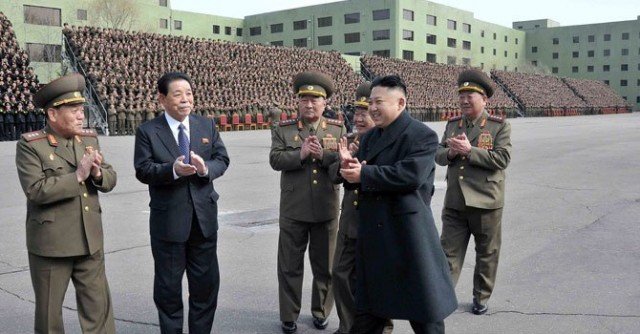
North Korea has threatened to shut down Kaesong Industrial Complex reiterating the state of war with South Korea
The industrial park funnels more than $92 million a year in wages for 53,400 North Koreans employed there, and its operation has survived despite years of military tensions. The latest threat to close down Kaesong came amid a torrent of bellicose statements by North Korea in recent days, widely seen as a strategy to increase pressure on South Korea and the US to soften their policies on the North.
Although South Korean officials reasserted that they were ready to retaliate if North Korea committed any military provocations, they said they saw no imminent sign of any such attacks.
On Saturday, cross-border traffic operated as normal, allowing hundreds of South Koreans to travel to and from Kaesong.
Over 300 South Koreans remained in the complex, where 123 South Korean textile and other labor-intensive factories employ the North Korean workers, at an average monthly wage of $144.
The fate of Kaesong is seen as a crucial test of how far North Korea is willing to take its recent threats against the South. Its continued operation was often seen as a sign that Pyongyang’s verbal militancy was not necessarily matched by its actions.
“The South Korean puppet forces are left with no face to make complaint even though we ban the South side’s personnel’s entry into the zone and close it,” North Korea said Saturday in a statement carried by its official KCNA.
North Korea said its dignity was insulted by South Korean news media reports that suggested the North kept the complex open to obtain hard currency.
In another development, some of North Korea’s main government-run Web sites were disabled on Saturday in what news media reports said were cyber attacks.
The disabled sites included those of Naenara, the government’s official Web portal; Air Koryo, the state-run airline; and Voice of Korea, Pyongyang’s international broadcast outlet.
North Korea Tech, a Web site that monitors Internet activities on the Korean Peninsula, said the problems appeared “to be part of a loosely coordinated effort by hackers to target North Korean sites.” By late Saturday afternoon, North Korean officials had not confirmed any attacks on government-run Web sites.
The problems come as some analysts suspect that cyber attacks have become an increasingly frequent weapon in the intensified sparring between the Koreas, although each side denies hacking the other.
South Korean officials suspect that North Korea was behind cyber attacks on March 20 against three banks and the country’s two largest broadcasters. The attacks came five days after North Korea blamed South Korea and the US for cyber attacks that temporarily shut down some of its official Web sites, and warned of “consequences”.
North Korea has been angry ever since South Korea and the US started a joint military exercise in early March. Its bellicosity further escalated when the UN imposed more sanctions against it after its February 12 nuclear test.
North Korea has since declared an “all-out action” against Washington and Seoul and said that the armistice that stopped the Korean War in 1953, as well as all nonaggression agreements with South Korea were nullified.
North Korean leader, Kim Jong-un, ordered all his missile units to be on standby and if provoked, attack the US and South Korea with nuclear-tipped long-range missiles, although most analysts doubt the North has them.
A statement by South Korea’s military said that although the North Korean threats were not new, they “are unacceptable and harm the peace and stability of the Korean Peninsula.”
[youtube S-W6B0fUvjs]
North Korea has declared “state of war” against South Korea in its latest escalation of rhetoric against its neighbour and the US.
A statement promised “stern physical actions” against “any provocative act”.
North Korea has threatened attacks almost daily after it was sanctioned for a third nuclear test in February.

North Korea has declared “state of war” against South Korea in its latest escalation of rhetoric against its neighbour and the US
However, few think the North would risk full-blown conflict, and the two sides have technically been at war since 1953 as no peace treaty has been signed.
An armistice at the end of the Korean War was never turned into a full treaty.
North Korea carried out its third nuclear test on February 12, which led to the imposition of fresh sanctions.
The annual US-South Korean military exercises have also taken place, angering Pyongyang further.
Many analysts believe that all-out war with South Korea and its ally the United States would be suicidal for the North, says the BBC’s Lucy Williamson in Seoul.
But with both sides threatening heavy retaliation, there’s a chance of minor incidents escalating, our correspondent adds.
A North Korean statement released on Saturday said: “From this time on, the North-South relations will be entering the state of war and all issues raised between the North and the South will be handled accordingly.
“The long-standing situation of the Korean peninsula being neither at peace nor at war is finally over.”
In Washington, Caitlin Hayden, a spokeswoman for the National Security Council, said the US had “seen reports of a new and unconstructive statement from North Korea”.
“We take these threats seriously and remain in close contact with our South Korean allies,” she said.
North Korea has made multiple threats against both the US and South Korea in recent weeks, including warning of a “pre-emptive nuclear strike” on the US and the scrapping of the Korean War armistice.
On Thursday, North Korean state media reported leader Kim Jong-un “judged the time has come to settle accounts with the US imperialists”.
Kim Jong un was said to have condemned US B-2 bomber sorties over South Korea during military exercises as a “reckless phase” that represented an “ultimatum that they will ignite a nuclear war at any cost on the Korean peninsula”.
US mainland and bases in Hawaii, Guam and South Korea were all named as potential targets.
State media in the North showed thousands of soldiers and students at a mass rally in Pyongyang supporting Kim Jong-un’s announcement
North Korea’s most advanced missiles are thought to be able to reach Alaska, but not the rest of the US mainland.
White House spokesman Josh Earnest said the rhetoric only deepened North Korea’s isolation.
China, North Korea’s biggest trading partner, has reiterated its call for all sides to ease tensions.
Foreign ministry spokesman Hong Lei told a daily news conference that “joint efforts” should be made to turn around a “tense situation”.
Russian Foreign Minister Lavrov went further, voicing concern that “we may simply let the situation slip out of our control”.
“We are concerned that… unilateral action is being taken around North Korea that is increasing military activity,” he said.
On March 16, North Korea warned of attacks against South Korea’s border islands, and advised residents to leave the islands.
In 2010, North Korea shelled South Korea’s Yeonpyeong island, causing four deaths.
[youtube MgT9o0So7C8]
Russia has warned of tensions in North Korea slipping out of control, after Pyongyang announced it was placing its rockets on stand-by.
Russian Foreign Minister Sergei Lavrov warned the situation could slip “toward the spiral of a vicious circle”.
North Korean leader Kim Jong-un made the missile order after talks responding to US stealth bomber flights over the Korean peninsula, state news agency KCNA said.
The time had come to “settle accounts” with the US, KCNA quoted him as saying.
Annual military drills and fresh UN sanctions have angered North Korea.
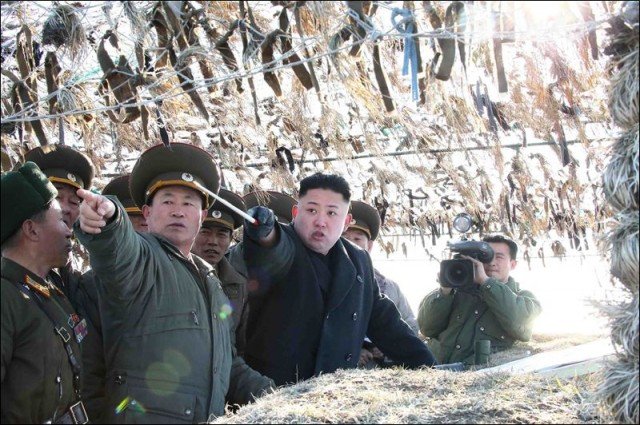
Russia has warned of tensions in North Korea slipping out of control, after Pyongyang announced it was placing its rockets on stand-by
After a late-night meeting with the army’s strategic rocket force, Kim Jong-un “judged the time has come to settle accounts with the US imperialists”, KCNA reported.
Kim Jong-un was said to have condemned US B-2 bomber sorties over South Korea as a “reckless phase” that represented an “ultimatum that they will ignite a nuclear war at any cost on the Korean Peninsula”.
US mainland and bases in Hawaii, Guam and South Korea were all named as potential targets.
The US – which flew two stealth bombers over the peninsula on Thursday as part of the ongoing annual US-South Korea military drills – has said it is ready for “any eventuality” on the peninsula.
Thousands of North Korean soldiers and students later took part in a mass rally in the centre of Pyongyang in support of Kim Jong-un’s announcement, beneath large portraits of his father Kim Jong-il and grandfather Kim Il-sung.
A South Korean defence ministry spokesman described the North Korean decision as a “continuing measure”, after its announcement to adopt “combat posture”.
China, North Korea’s biggest trading partner, immediately reiterated its call for all sides to ease tensions.
But Russian Foreign Minister Sergei Lavrov went further, voicing concern that “we may simply let the situation slip out of our control and it will slide into a spiral of a vicious circle”.
While condemning Pyongyang’s actions as “unacceptable”, Sergei Lavrov gave a more general warning that “unilateral steps being taken around North Korea that manifest themselves in a build-up of military activity”.
Sergei Lavrov added what was needed was not a build-up of military muscle and a pretext for using military means to achieve “geopolitical objectives”, in remarks seen as an implicit criticism of US bomber flights.
[youtube BAQK8ZhamhM]
North Korea announces it has put missile units on stand-by to attack US targets in response to US stealth bomber flights over the Korean peninsula.
State news agency KCNA said leader Kim Jong-un signed off on the order at a late-night meeting of top generals.
The time had come to “settle accounts” with the US, KCNA quoted him as saying, with the B-2 flights an “ultimatum”.
Pyongyang has been angered by fresh UN sanctions and annual US-South Korea military drills.
China, North Korea’s biggest trading partner, has called on all sides to ease tensions.

North Korea announces it has put missile units on stand-by to attack US targets in response to US stealth bomber flights over the Korean peninsula
Kim Jong-un “finally signed the plan on technical preparations of strategic rockets of the KPA, ordering them to be stand-by for fire so that they may strike any time”, the KCNA report said.
“If they make a reckless provocation with huge strategic forces, the Korean People’s Army (KPA) should mercilessly strike the US mainland, their stronghold, their military bases in the operational theatres in the Pacific, including Hawaii and Guam, and those in South Korea,” the agency quoted him as saying.
Thousands of North Koreans later took part in a march in Pyongyang in support of Kim Jong-un’s announcement, the Associated Press news agency reported.
A Yonhap news agency report citing an unidentified military official said increased activity had been noted at North Korea’s missile sites, but this remains unconfirmed.
The US – which flew two stealth bombers over the peninsula on Thursday as part of the ongoing military drills – has said it is ready for “any eventuality” on the peninsula.
In a statement, it said that the B-2 planes demonstrated America’s ability to “provide extended deterrence” to its allies and conduct “long-range, precision strikes quickly and at will”.
“The North Koreans have to understand that what they’re doing is very dangerous,” US Defence Secretary Chuck Hagel told reporters on Thursday.
“We must make clear that these provocations by the North are taken by us very seriously and we’ll respond to that.”
The US flew nuclear-capable B-52 bombers over South Korea earlier this month, in what it called a response to escalating North Korean threats.
In Beijing, Chinese Foreign Ministry spokesman Hong Lei reiterated a call for calm on all sides.
Hong Lei told a daily news briefing that “joint efforts” should be made to turn around a “tense situation”. He made similar remarks on Tuesday.
Tensions in the Korean peninsula are high following North Korea’s third nuclear test on February 12, which led to the imposition of a fresh raft of sanctions.
North Korea has made multiple threats against both the US and South Korea in recent weeks, including warning of a “pre-emptive nuclear strike” on the US and the scrapping of the Korean War armistice.
North Korea is not thought to have the technology to strike the US mainland with either a nuclear weapon or a ballistic missile, but it is capable of targeting some US military bases in Asia with its mid-range missiles.
While North Korea has issued many threats against the US and South Korea in the past, this level of sustained rhetoric is rare, observers say.
On March 16, North Korea warned of attacks against South Korea’s border islands, and advised residents to leave the islands. In 2010 it shelled South Korea’s Yeonpyeong island, causing four deaths.
On Wednesday, Pyongyang also cut a military hotline with the South – the last direct official link between the two nations.
A Red Cross hotline and another line used to communicate with the UN Command at Panmunjom have already been cut, although an inter-Korean air-traffic hotline still exists.
The jointly-run Kaesong industrial park is still in operation, however, and over 160 South Korean commuters entered North Korea yesterday to work in its factories.
Kaesong Industrial Complex employs an estimated 50,000 North Korean workers and is a source of badly-needed hard currency for the North.
[youtube wSfkZO_LRno]
Kaesong Industrial Complex at the North-South Korea border is still operating despite Pyongyang cutting a military hotline with South Korea on Wednesday.
The hotline had been used mainly to facilitate cross-border travel at the Kaesong Industrial Complex for South Korean workers.
It was the last direct official link between the two nations.
Pyongyang has been angered by US-South Korea military drills, and the fresh UN sanctions that followed its third nuclear test in February.
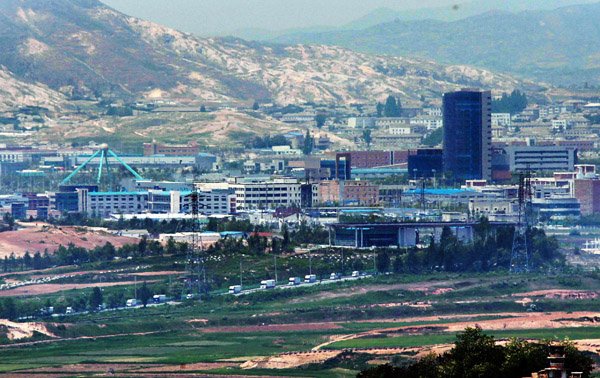
Kaesong Industrial Complex at the North-South Korea border is still operating despite Pyongyang cutting a military hotline with South Korea
In recent weeks North Korea has made multiple threats against both the US and South Korea, including warning of a “pre-emptive nuclear strike” on the US and the scrapping of the Korean War armistice.
North Korea is not thought to have the technology to strike the US mainland with either a nuclear weapon or a ballistic missile, but it is capable of targeting some US military bases in Asia with its mid-range missiles.
More than 160 South Korean commuters went through border control on Thursday morning to start work at the complex, after being approved for entry by North Korea, officials said.
North Korean authorities had used a civilian phone line to arrange the crossing, they added.
Over 500 South Koreans are scheduled to cross the border in Kaesong in Thursday.
“We say that Kaesong industrial complex will go on running, even if the war breaks out. I don’t feel so nervous,” Jang Seon-woo, a South Korean worker, told AP news agency.
The joint project in Kesong, which was established as a sign of North-South co-operation, is a source of badly-needed hard currency for the North.
Around 120 South Korean firms operate at Kaesong industrial park, employing an estimated 50,000 North Korean workers.
There have been disputes and the North Koreans have, on occasion, blocked access across the Demilitarized Zone that divides the two Koreas, who remain technically at war.
North Korea has already cut both a Red Cross hotline and another line used to communicate with the UN Command at Panmunjom in the demilitarized zone.
An inter-Korean air-traffic hotline still exists between the two sides, according to reports.
Meanwhile, in a phone call on Wednesday, US Defense Secretary Chuck Hagel told his South Korean counterpart Kim Kwan-Jin that the US would provide “unwavering” support to South Korea.
Chuck Hagel also told his South Korean counterpart that the US-South Korea alliance was “instrumental in maintaining stability on the Korean peninsula,” Pentagon spokesman George Little said in a statement.
On Tuesday, North Korea said it had ordered artillery and rocket units into “combat posture” to prepare to target US bases in Hawaii, Guam and the US mainland.
In a statement on Wednesday, North Korea’s official news agency KCNA also said that North Korea’s air force was ready to “wipe out” US military bases in Guam.
However, Guam Governor Eddie Baza Calvo described an attack as “unlikely” and urged residents not to let the threats “distract from [their] day-to-day lives”.
[youtube FwdaTCe9zmY]
North Korea has announced it severs another military hotline with South Korea.
The hotline is used to facilitate the travel of South Korean workers to a joint industrial complex in Kaesong, North Korea.
Pyongyang has been angered by fresh UN sanctions following its February 12 nuclear test and US-South Korea military drills.
In recent weeks its habitually fiery rhetoric has escalated, with multiple warnings issued.

North Korea has announced it severs Kaesong military hotline with South Korea
On Tuesday, North Korea said it had ordered artillery and rocket units into “combat posture” to prepare to target US bases in Hawaii, Guam and the US mainland.
North Korea has also threatened a “pre-emptive” nuclear strike against the US in recent days and told the South it has scrapped the Korean War armistice agreement.
While the situation is currently unpredictable, some analysts believe Pyongyang may be trying to force the US and others into negotiations, with all-out war unlikely.
Pentagon spokesman George Little said on Tuesday that North Korea’s threats “followed a pattern designed to raise tensions” and that North Korea would “achieve nothing by these threats”.
North Korea has already cut both a Red Cross hotline and another used to communicate with the UN Command at Panmunjom in the Demilitarized Zone that divides the two Koreas.
The military hotline is used by the two sides to communicate over travel to the Kaesong joint industrial zone, inside North Korea.
“Under the situation where a war may break out any moment, there is no need to keep up North-South military communications,” a senior North Korean military official was quoted by KCNA news agency as telling South Korea before the line was severed.
Until now, operations at the joint complex have been normal despite the rise in tensions.
South Korea’s Ministry of Unification confirmed that North Korea was no longer answering calls to the hotline, reports Yonhap news agency.
[youtube g748T-ojqQ4]
North Korea has hit out at South Korea’s President Park Geun-hye, a day after she urged Pyongyang to change course and abandon its nuclear goals.
Warning her against “slandering”, North Korea told Park Geun-hye to behave with discretion to avoid “horrible disaster”.
Park Geun-hye’s comments came as she marked three years since the deadly sinking of a South Korean warship.
Overnight, meanwhile, South Korea briefly placed a border military unit on its highest alert.
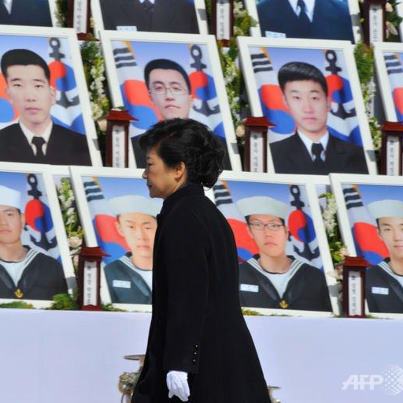
South Korea’s President Park Geun-hye spoke in Daejeon, where the 46 sailors who died when the Cheonan warship sank on 26 March 2010 are buried
The alert happened early on Wednesday after a South Korean soldier discovered a “strange object” at the border, military officials said. The alert prepares troops for a possible incursion from North Korea.
The soldier, who was at a military post in Hwacheon, in South Korea’s north-eastern Gangwon province, threw a grenade at the object at around 02:30 local time, officials said. The alert was lifted at 09:20 local time.
Tensions are high on the Korean peninsula following multiple threats from North Korea in recent days.
The border incident came hours after North Korea said it had ordered artillery and rocket units into “combat posture” to prepare to target US bases in Hawaii, Guam and the US mainland.
Pentagon spokesman George Little said that North Korea’s threats “followed a pattern designed to raise tensions” and that North Korea would “achieve nothing by these threats”.
North Korea has been angered by fresh UN sanctions imposed after its nuclear test on February 12. It also bitterly opposes joint US-South Korea military drills that are currently taking place.
In its latest statement, carried by state-run KCNA news agency, North Korea told President Park Geun-hye that its patience was being pushed to the limit.
“She should behave with discretion, clearly mindful that a wrong word may entail horrible disaster at a time when the North-South relations are being pushed to the lowest ebb and the danger of an all-out war is increasing on the Korean Peninsula,” it said.
“If she keeps to the road of confrontation like traitor [former president] Lee [Myung-bak], defying the warnings of the DPRK [North Korea], she will meet a miserable ruin.”
On Tuesday Park Geun-hye had told the North its only path to survival lay “in stopping provocations and threats, abandoning its nuclear weaponry and missiles”.
Park Geun-hye spoke in Daejeon, where the 46 sailors who died when the Cheonan warship sank on 26 March 2010 are buried. South Korea says a North Korean torpedo sank the ship; Pyongyang denies any role in the incident.
The South Korean president has spoken in the past of a desire for more dialogue with North Korea but current tensions are obstructing movements to improve ties.
Late on Tuesday, North Korean state-run media also reported that its top political bureau would soon hold a rare meeting to discuss “an important issue for victoriously advancing the Korean revolution”.
It did not specify the issue, or the date of the meeting.
[youtube gWCKyDuRLe0]
North Korea announces it has ordered artillery and rocket units into “combat posture” to prepare to target US bases in Hawaii, Guam and the US mainland.
The announcement, carried by KCNA news agency, follows days of strong rhetoric from Pyongyang.
The north Korean move came as South Korea marked the third anniversary of the sinking of the Cheonan warship, which left 46 sailors dead.
South Korea said it had detected no signs of unusual activity in the North.
Tensions remain high on the Korean peninsula in the wake of North Korea’s third nuclear test on February 12. The test led to new UN sanctions which Pyongyang strongly opposes.
Joint US-South Korea annual military drills have further angered the communist nation. In recent weeks its habitually fiery rhetoric has escalated – it has threatened the US with “pre-emptive nuclear attacks”, as well as strikes on US military bases in Japan.
“From this moment, the Supreme Command of the Korean People’s Army will be putting in combat duty posture No 1 all field artillery units including long-range artillery units and strategic rocket units that will target all enemy objects in US invasionary bases on its mainland, Hawaii and Guam,” the KCNA statement said.

North Korea announces it has ordered artillery and rocket units into “combat posture” to prepare to target US bases in Hawaii, Guam and the US mainland
North Korea is not thought to have the technology to strike the US mainland with either a nuclear weapon or a ballistic missile, but it is capable of targeting US military bases in the region with its mid-range missiles.
North Korea’s announcement comes as the country carries out large-scale military exercises, and it is not clear whether the order applies to the army as a whole or just to specific units.
In a press briefing, Chinese Foreign Ministry spokesman Hong Lei said that he hoped that “relevant parties [would] exercise restraint so as to ease the tension”.
The statement came hours after South Korean President Park Geun-hye called on North Korea to “change course” by abandoning nuclear weapons.
Speaking at the national cemetery in Daejeon where the sailors who died when the warship sank are buried, Park geun-hye said North Korea continued to threaten the South’s national security.
“For the North, the only path to survival lies in stopping provocations and threats, abandoning its nuclear weaponry and missiles, and becoming a responsible member of the international community,” she said.
The Cheonan sank in 2010 near the disputed inter-Korean western maritime border. South Korea says a North Korean torpedo sank the ship but Pyongyang denies any involvement.
Months later, North Korea shelled a border island, Yeonpyeong, in the same area, killing four South Koreans, including two civilians. It said it was responding to military exercises in the South.
Last week, South Korea and the US signed a new military plan – conceived after the shelling – pledging joint action to counter limited attacks from North Korea.
Meanwhile, websites of associations for North Korean defectors said that their networks crashed earlier on Tuesday. They said that they were victims of a cyber-attack.
Officials said that South Korean broadcaster YTN’s network and a computer network used by seven local governments were also briefly paralyzed, Yonhap news agency reported.
Daily NK, a news site focused on North Korea, said in a post on its Facebook page that it had “experienced a cyber-attack at 13:40” local time on Tuesday.
Free North Korea Radio, a radio broadcaster, also said that its website “was completely destroyed” after an attack around noon, Yonhap reported.
The presidential office, Cheong Wa Dae, said in a statement that the government was “closely working to confirm if the paralysis cases were caused by technical problems or hacking attacks”.
A cyber-attack on six South Korean banks and broadcasters last week disrupted 32,000 computers and some banking services.
The origin of the attack is not yet known, although there has been speculation that North Korea could have been to blame.
North Korea has been blamed for previous cyber-attacks on the South in 2009 and 2011.
[youtube kLd02dQueFk]
South Korea and the United States have signed a new military plan to counter what officials call North Korean “provocations”.
The plan provides for a joint response between South Korea and the US in the event of an incursion or a limited attack from North Korea, officials say.
Help from the US – which has 28,000 troops in South Korea – during minor skirmishes was previously optional.
Regional tension remains high after the North’s third nuclear test last month.
The US already offers South Korea a “nuclear umbrella”, but Cold War experts have pointed out that while nuclear deterrence may address the possibility of all-out war, it does not deter low-level incidents.

South Korea and the US have signed a new military plan to counter what officials call North Korean provocations
Under the new plan, South Korea will be able to call on US assistance should Pyongyang follow through with its recent threats, for example to attack remote South Korean islands.
“This allows both nations to jointly respond to the North’s local provocations, with the South taking the lead and the US in support,” South Korean defence ministry spokesman Kim Min-seok said on Monday.
“It will have the effect of preventing the North from daring to provoke us,” he added of the deal, which was signed on Friday.
The “provocative” acts that the plan seeks to address include incursions on the border and by low-flying aircraft, and attacks on border islands.
The new plan was conceived in 2010, after North Korea shelled a border island. A South Korean warship also sank that year, leaving 46 sailors dead. South Korea said North Korea torpedoed the ship, but Pyongyang denied this.
Last month the UN imposed fresh sanctions against North Korea following its nuclear test on February 12.
Pyongyang has responded with escalating rhetoric both to this and US-South Korea joint military drills which it bitterly opposes.
North Korea says it has scrapped the Korean War armistice and ended non-aggression pacts with Seoul.
South Korea says North Korea cannot unilaterally dissolve the armistice and has called on Pyongyang to tone down its language.
[youtube k4JstBdOsgk]
South Korean officials announce they incorrectly linked a Chinese IP address to a cyber-attack on local banks and broadcasters earlier this week.
On Thursday, the Korean Communications Commission said it had traced the attack to an internet address in China, although the identity of those behind the attack could not be confirmed.
But it said further investigation showed the malware came from a local computer in one of the affected banks.
However, South Korean officials still believe the attack was orchestrated from abroad.
Wednesday’s cyber-attack on six South Korean banks and broadcasters affected 32,000 computers and disrupted banking services.
The apparent link to China had fuelled speculation that North Korea was to blame.
Hackers can route their attacks through addresses in other countries to obscure their identities, and intelligence experts believe that North Korea routinely uses Chinese computer addresses to hide its cyber-attacks.
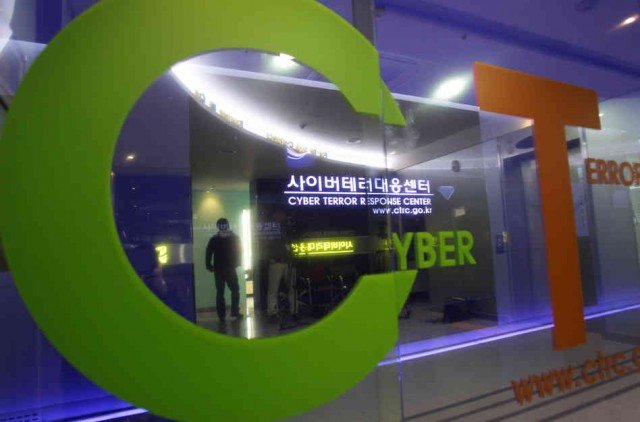
South Korean officials announce they incorrectly linked a Chinese IP address to a cyber-attack on local banks and broadcasters earlier this week
North Korea has been blamed for previous cyber-attacks on the South in 2009 and 2011.
South Korean officials initially linked the cyber-attack to an IP address in China, but on Friday said they had made a mistake.
Further investigation showed the IP address was in the internal server of Nonghyup bank, one of the victims of Wednesday’s attack.
Its IP address “coincidentally matched” a Chinese IP address, the KCC said.
“Malicious code seemed to be spread from the server [of Nonghyup Bank] and there were records of [it] being approached by someone at that time,” Lee Jae-il, vice-president of Korea’s Internet Security Agency (KISA), told reporters.
“We’re still tracking some dubious IP addresses which are suspected of being based abroad,” he said, adding that they were “keeping all kinds of possibilities open”.
The United Nations human rights council has set up an inquiry into human rights abuses in North Korea for the first time.
The UN council unanimously voted for the probe, which will examine allegations of prison camps, slave labor and food deprivation in North Korea.
North Korea denounced the resolution as a political ploy.
It is highly unlikely the team will be granted access to North Korea, so they will have to rely on satellite imagery and accounts from defectors.
North Korea’s human rights record will now be under intense scrutiny, and evidence gathered by the team could be used in future prosecutions for crimes against humanity.
UN special rapporteur Marzuki Darusman, who presented the initial report on North Korea and will be a member of the inquiry, said that a key focus should be the country’s prison camps.
“The prison camps could qualify as crimes against humanity,” he said.
“These are camps which have the purpose of driving the people being detained there towards a slow death.”
Marzuki Darusman’s report also described “widespread and systematic violations of human rights” including enforced disappearances and using food to control people.
UN High Commissioner for Human Rights Navi Pillay said the UN had evidence indicating that North Korea’s political prisons held around 200,000 people, with many subjected to rape, torture and slave labor.
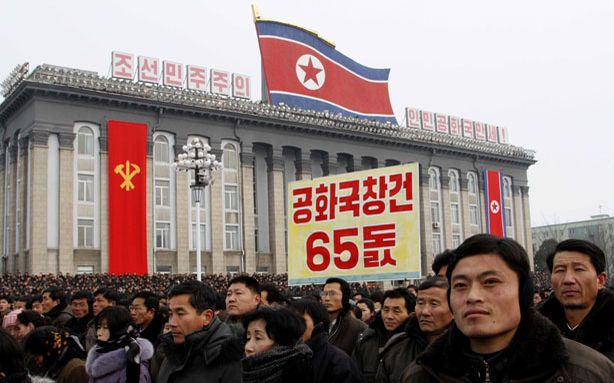
The UN human rights council has set up an inquiry into human rights abuses in North Korea for the first time
The resolution, which was presented by Japan and the European Union, was approved by all 47 members of the council.
“For too long the population of the country has been subjected to widespread and systematic human rights violations and abuses,” Ireland’s Foreign Minister Eamon Gilmore said, speaking on behalf of the EU.
North Korea’s ambassador to the UN, Pyong Se-so, called the resolution “a faked document full of political invective, with serious distortions.”
Pyong Se-so accused the council of seeking to “disgrace the image” of North Korea, adding that his country had “one of the best systems in the world for the protections of human rights”.
The inquiry has been welcomed by activists. In a statement, Human Rights Watch described the move as a “landmark step”, that would “help expose decades of abuse by the North Korean government”.
The probe comes at a time of heightened tensions in the Korean peninsula, following North Korea’s third nuclear test in February and the subsequent tightening of UN sanctions.
On Friday, the US voiced optimism that China would help enforce UN sanctions, a key part of which involves stopping money flow to Pyongyang’s nuclear programme and illicit arms sales.
“We asked the Chinese for enhanced scrutiny of financial institutions in North Korea,” said US Treasury Undersecretary David Cohen, who is visiting Beijing.
“It’s no secret that there is a fair amount of financial relationship between China and North Korea and Chinese financial institutions in North Korea.”
In recent days North Korean rhetoric against both the US and South Korea has escalated.
On Thursday, the North Korean army issued a statement threatening US military bases in Japan, in response to the US flying nuclear-capable B-52 bombers over South Korea as part of a joint military exercise.
[youtube it0wsPvkwZU]
South Korean officials have announced that the cyber-attack on the country’s banks and broadcasters came from an internet address in China.
However, the identity of those behind the cyber attack cannot be confirmed.
The telecoms regulator said hackers used a Chinese address to plant a malicious code that hit networks at six organizations on Wednesday.
Officials said they were continuing to investigate the origins of the attack.
North Korea has been blamed for previous attacks in 2009 and 2011.
“Unidentified hackers used a Chinese IP address to contact servers of the six affected organizations and plant the malware which attacked their computers,” said Park Jae-moon of South Korea’s communications regulator.
“At this stage, we’re still making our best efforts to trace the origin of attacks, keeping all kinds of possibilities open,” he said.
Officials stressed that the IP address did not reveal who was behind the attack, as hackers can route their attacks through addresses in other countries to obscure their identities.
However, the discovery has strengthened speculation that North Korea was behind the attack.

South Korean officials have announced that the cyber-attack on the country’s banks and broadcasters came from an internet address in China
Intelligence experts believe that North Korea routinely uses Chinese computer addresses to hide its cyber-attacks.
A taskforce is being formed to analyze the virus and stop further attacks, and free computer vaccines have been handed out to South Korean companies.
Korea’s Communications Commission (KCC) said that the attacks on all six organizations appeared to come from a single entity.
The networks had been attacked by malicious codes, rather than distributed denial-of-service (DDoS) attacks as initially suspected.
Following Wednesday’s attack, the KCC raised its cyber-attack alert levels to “caution,” the third highest out of five levels, news agency Yonhap reported.
Around 32,000 computers were affected by the incident, and some services at Shinhan bank, including internet banking and ATM machines, were disrupted.
However, so far no damage had been detected in public institutions and infrastructure, the KCC was quoted as saying by Yonhap.
The incident comes with tensions between the two Koreas high.
North Korea has stepped up rhetoric in recent days in response to fresh UN sanctions over its nuclear test in February and joint annual military drills between the US and South Korea, which it bitterly opposes.
On March 15, North Korea’s KCNA news agency also accused the US and its allies of “intensive and persistent” hacking attacks on its internet servers.
[youtube 2sT_4tj2xAM]
South Korea’s authorities are investigating a suspected cyber-attack that has paralyzed computer networks at broadcasters and banks.
Broadcasters KBS, MBC and YTN told police their networks were halted around 14:00, Yonhap news agency said.
Two banks, Shinhan Bank and Nonghyup, said their networks were affected.
The exact cause of the problems remains unknown. Last week, North Korea accused the US and its allies of attacks on its internet servers.
The networks had been “partially or entirely crippled”, the Korean Internet Security Agency (KISA), a state watchdog, said.
“This incident is pretty massive and will take a few days to collect evidence,” a police official told AFP news agency.
Staff at the three broadcasters said their computers crashed and could not be restarted, with screens simply displaying an error message, although they have continued to make television broadcasts.
There are reports of skulls popping up on some computer screens, which could indicate that hackers had installed malicious code in the networks, KISA said.
Some banking services at Shinhan bank, including internet banking and ATM machines, were also affected, although banking operations now appear to have been restored.
A third bank, Woori Bank, also came under attack but was not infected, authorities say.
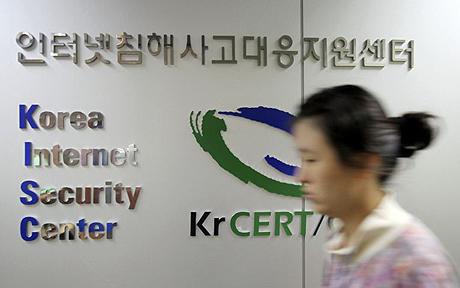
South Korea’s authorities are investigating a suspected cyber-attack that has paralyzed computer networks at broadcasters and banks
South Korean internet service provider LG Uplus said it believed its network had been hacked, Reuters news agency reported, citing an unidentified spokesman.
But AP news agency reported LG Uplus spokesman Lee Jung-hwan as saying that the company’s networks were operating normally, with no signs of a cyber-attack.
An official from the presidential office told Yonhap the authorities were “now trying to determine the cause of the network paralysis”, adding it was not yet known whether North Korea was involved.
“We do not rule out the possibility of North Korea being involved, but it’s premature to say so,” Defence Ministry spokesman Kim Min-seok said.
No government-related computer networks had been affected, an official from the National Computing and Information Agency (NCIA) told the agency.
The military has upgraded its information surveillance status by one level, Yonhap said.
North Korea is believed to have been behind two major cyber-attacks on the South in 2009 and 2011 that targeted government agencies and financial firms.
Nonghyup bank was one of the victims of the 2011 attack, which left its customers unable to access or transfer their cash for three days.
North Korea has stepped up rhetoric in recent days in response to fresh UN sanctions over its nuclear test in February and joint annual military drills between the US and South Korea, which it bitterly opposes.
Last week, North Korea’s KCNA news agency accused the US and its allies of “intensive and persistent” hacking attacks on its networks.
Official sites such as KCNA, Air Koryo and Rodong Sinmun, the party newspaper, were reportedly inaccessible for short periods.
[youtube cNbXhSPZ3TU]
The US is flying nuclear-capable B-52 bombers over South Korea, in what it says is a response to escalating North Korean rhetoric.
US officials said the B-52 flights demonstrated “extended deterrence capabilities” amid rising tension on the peninsula.
B-52, which can also carry conventional weapons, flew on March 8, with another mission set for Tuesday.
Regional tension remains high following North’s third nuclear test last month.
This is not the first time that B-52 bombers have been used as part of regular military drills between the US and South Korea.
“We’re drawing attention to the fact that we have extended deterrence capabilities that we believe are important to demonstrate in the wake of recent North Korean rhetoric,” Pentagon press secretary George Little said.
“As North Korea threatened to attack South Korea with nuclear weapons, the exercise involving B-52s is meaningful, as it shows US commitment to provide its nuclear umbrella on the Korean peninsula,” said Kim Min-seok, spokesman for South Korea’s Defence Ministry.
US Deputy Defence Secretary Ashton Carter affirmed this commitment on Monday during a visit to Seoul.
The US last week also announced plans to boost its own missile defences in the face of a growing threat from North Korea, a move over which both China and Russia have expressed concern.
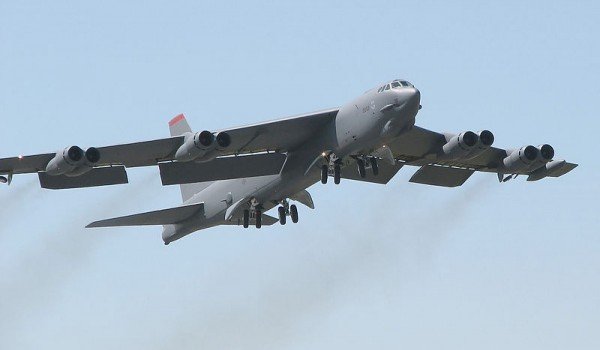
The US is flying nuclear-capable B-52 bombers over South Korea, in what it says is a response to escalating North Korean rhetoric
A spokesman for China’s Foreign Ministry said it would “intensify antagonism”, rather than improving regional stability.The UN imposed fresh sanctions against North Korea following its nuclear test on February 12.
Pyongyang has responded with strong rhetoric to this and the US-South Korea joint military drills, which it bitterly opposes.
It says it has scrapped the Korean War armistice and ended non-aggression pacts with Seoul. It has also cut off a hotline that connects the two countries.
The two Koreas remain technically at war because the 1950-53 conflict ended in an armistice, not a treaty.
South Korea says North Korea cannot unilaterally dissolve the armistice and has called on Pyongyang to tone down its language.
South Korean President Park Geun-hye on Tuesday called for North Korea to take a different approach.
“North Korea is wasting resources for nuclear development while its people are living very difficult lives,” she said.
North Korean propaganda website Uriminzokkiri has warned of strikes against South Korea’s islands and advised residents to leave.
The Uriminzokkiri website, linked to the regime, mentioned targets including Yeonpyeong island, which was attacked by Northern forces in 2010.
Pyongyang has made a series of threats since its last nuclear test in February prompted the UN to tighten sanctions.
The US said on Friday it would refocus missile defences to its west coast to counter the North’s threats.
Defence Secretary Chuck Hagel said 14 more batteries would be placed in Alaska by 2017, adding to 30 already in place along the coast.
On February 12 North Korea tested a nuclear device, which is believed to be its third such test.
The UN Security Council condemned the move and tightened sanctions on the regime.
Before and after the UN announcement, Pyongyang promised reprisals for the sanctions, including a threat to launch a pre-emptive nuclear strike against the US.

North Korean propaganda website Uriminzokkiri has warned of strikes against South Korea’s islands and advised residents to leave
North Korean media has also been vitriolic against the South.The Uriminzokkiri website stated: “Even an accidental spark by the belligerents in their war games can grow into a fire.
“And the damage for those living along the border and on the five western islands will be great.”
The threats came shortly after South Korea’s PM Chung Hong-won visited Yeonpyeong.
The US and South Korea also began military drills earlier in the week.
South Korea’s western islands are regarded as being particularly vulnerable to attack as they lie 6 miles south of the sea boundary.
In 2010, North korea bombarded Yeonpyeong with artillery shells, causing four deaths.
North Korea’s foreign policy has for decades been dominated by threats of military strikes, and bartering over its nuclear programme.
Although Pyongyang has given up parts of its nuclear programme in return for aid, it has continued to develop missiles and enrich nuclear material.
The most advanced missiles have the capacity to reach Alaska.
It is not thought to have a missile capable of carrying a nuclear warhead.
Defence Secretary Chuck Hagel has announced plans to boost missile defences on the United States West Coast to counter the threat from North Korea.
Chuck Hagel said the US would add 14 interceptors, which can shoot down missiles in flight, to 30 already in place in California and Alaska by 2017.
He cited a “series of irresponsible and reckless provocations” recently by North Korea.
Tensions have risen after Pyongyang’s third nuclear test last month.
Only last week North Korea threatened the US with a pre-emptive nuclear strike.
However, despite North Korea’s latest fiery rhetoric, analysts say the regime is years away from producing a missile with the capability to reach the continental US.
“The US has missile defences to protect us from limited ICBM [Inter-Continental Ballistic Missile] attacks,” Chuck Hagel told Friday’s press conference.
“But North Korea in particular has recently made advances in its capabilities and has engaged in a series of irresponsible and reckless provocations.”

Defence Secretary Chuck Hagel has announced plans to boost missile defences on the US West Coast to counter the threat from North Korea
Chuck Hagel said the US would also deploy a radar-tracking station in Japan.He continued: “The reason we’re doing what we’re doing, and the reason we’re advancing our programme here for homeland security is not taking any chances, is to stay ahead of the threat and to ensure any contingencies.”
Chuck Hagel said the additional 14 interceptors would be deployed to Fort Greely, in Alaska, at a cost of about $1 billion.
He also announced the Pentagon was beginning environmental impact studies for additional interceptor sites, allowing a shorter timeline for construction if the president decides to go ahead with installing further interceptors.
The Alaska and California sites were built during the presidency of George W. Bush as protection from a possible strike by North Korea.
Technical difficulties with the interceptors slowed their installation.
When asked about the “poor performance” of interceptors during recent trials, Chuck Hagel said further tests would be carried out this year.
“We have confidence in our system and we certainly will not go forward with the addition of the 14 interceptors until we’re sure we have the complete confidence we need.”
North Korea has accused the United States and its allies of attacks on its internet servers, amid tension on Korean peninsula.
KCNA news agency said the “intensive and persistent” attacks coincided with US-South Korea military drills.
Official sites such as KCNA, Air Koryo and Rodong Sinmun, the party newspaper, are reported to have been inaccessible on some occasions in recent days.
Tension has escalated in the wake of North Korea’s third nuclear test last month.
The test led to fresh UN sanctions being imposed on Pyongyang, which has responded with strong rhetoric – both to the UN move and the annual joint drills, which it bitterly opposes.
It says it has scrapped the Korean War armistice and ended non-aggression pacts with Seoul. It has also cut off a hotline that connects the two countries.
The two Koreas remain technically at war because the 1950-53 conflict ended in an armistice, not a treaty. South Korea says North Korea cannot unilaterally dissolve the armistice and has called on Pyongyang to tone down its language.
North Korea called the cyber attack a “cowardly and despicable act”.
“It is nobody’s secret that the US and South Korean puppet regime are massively bolstering up cyber forces in a bid to intensify the subversive activities and sabotages against the DPRK [North Korea],” KCNA said.
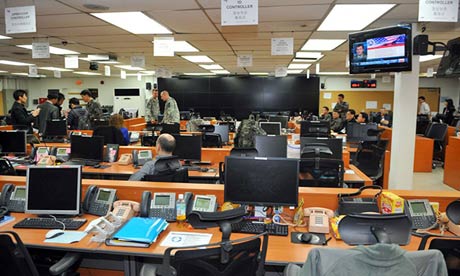
North Korea has accused the US and South Korea of attacks on its internet servers
However, accusations of cyber attacks on the peninsula usually flow in the opposite direction.South Korean intelligence sources say North Korea routinely attempts to access the network here, and Pyongyang is believed to have broken into Defence Ministry data at least once in the past few years, our correspondent adds.
Current internet access in North Korea is extremely limited for locals, with most people only having access to a small number of state-run pages. The wider internet is available only to the government and the military.
 Prev1...161718...21Next
Prev1...161718...21Next  Page 17 of 21
Page 17 of 21

























